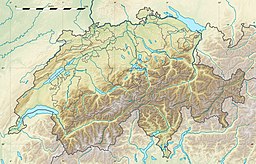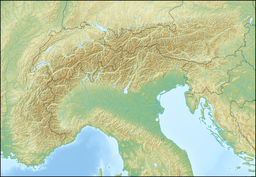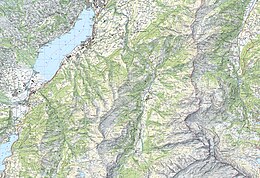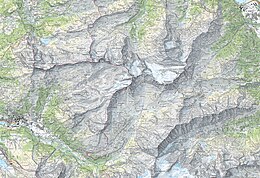Lake Lucerne
| Lake Lucerne | |
|---|---|
| Vierwaldstättersee(German) | |
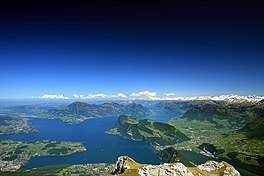 View of Lake Lucerne from thePilatus | |
 map | |
| Location | Central Switzerland |
| Coordinates | 47°01′10″N8°24′04″E/ 47.0194°N 8.4011°E |
| Lake type | freshwater fjord,recent regulation[note 1] |
| Primary inflows | |
| Primary outflows | Reuss |
| Catchment area | 2,124 km2(820 sq mi) |
| Basincountries | Switzerland |
| Max. length | 30 km (19 mi) |
| Max. width | 20 km (12 mi) |
| Surface area | 113.6 km2(43.9 sq mi) |
| Average depth | 104 m (341 ft) |
| Max. depth | 214 m (702 ft) |
| Water volume | 11.8 km3(2.8cu mi) |
| Residence time | 3.4 years |
| Shore length1 | 143.7 km (89.3 mi) |
| Surface elevation | 434 m (1,424 ft) |
| Frozen | in the 17th and 19th century; Lucerne Bay and Lake Alpnach in 1929 and 1963 |
| Islands | Altstatt-Insel |
| Sections/sub-basins | |
| Settlements | |
| Website | http://www.lakelucerne.ch |
| References | [1] |
 | |
| 1Shore length isnot a well-defined measure. | |
Lake Lucerne(German:Vierwaldstättersee,literally 'Lake of the fourforested settlements' (in English usually translated asforest cantons),French:lac des Quatre-Cantons,Italian:lago dei Quattro Cantoni) is alakein centralSwitzerlandand the fourth largest in the country.
Geography[edit]
The lake has a complicated shape, with several sharp bends and four arms. It starts in the south–north boundReussValley between steep cliffs above theUrnerseefromFlüelentowardsBrunnento the north before it makes a sharp bend to the west where it continues into theGersauer Becken.Here is also the deepest point of the lake with 214 m (702 ft). Even further west of it is theBuochser Bucht,but the lake sharply turns north again through the narrow opening between theUnter Nas(lower nose) of theBürgenstockto the west and theOber Nas(upper nose) of theRigito the east to reach theVitznauer Bucht.In front ofVitznaubelow the Rigi the lake turns sharply west again to reach the center of a four-arm cross, called theChrütztrichter(Cross Funnel). Here converge theVitznauer Buchtwith theKüssnachterseefrom the north, theLuzernerseefrom the west, and theHorwer Buchtand theStanser Trichterto the south, which is to be found right below the northeast side of the Pilatus and the west side of the Bürgenstock. At the very narrow pass between the east dropper of thePilatus(calledLopper) andStansstadthe lake reaches its southwestern arm atAlpnachstadon the steep southern foothills of the Pilatus, theAlpnachersee.The lake drains its water into the Reuss inLucernefrom its arm calledLuzernersee(which literally translates asLake of Lucerne).
The entire lake has a total area of 114 km2(44 sq mi) at an elevation of 434 m (1,424 ft) a.s.l., and a maximum depth of 214 m (702 ft). Its volume is 11.8 km3.Much of the shoreline rises steeply into mountains up to 1,500 m above the lake, resulting in many picturesque views including those of the mountains Rigi and Pilatus.
The Reuss enters the lake at Flüelen, in the part calledUrnersee(Lake of Uri,in thecanton of Uri) and exits at Lucerne. The lake also receives theMuotaat Brunnen, theEngelberger AaatBuochs,and theSarner Aaat Alpnachstad.
It is possible to circumnavigate the lake by train and road, though the railway route circumvents the lake even on the north side of the Rigi viaArth-Goldau.Since 1980, theA2 motorwayleads through theSeelisberg Tunnelin order to reach the route to theGotthard Passin just half an hour inAltdorf, Uriright south of the beginning of the lake in Flüelen.
Steamers and other passenger boats ply between the different villages and towns on the lake. It is a populartouristdestination,[2]both for native Swiss and foreigners, and there are many hotels and resorts along the shores. In addition, the meadow of theRütli,traditional site of the founding of theSwiss Confederation,is on theUrnerseeshore. A 35 km commemorative walkway, theSwiss Path,was built around the Lake of Uri to celebrate the country's 700th anniversary in 1991.
Archaeologistssurveying the lake-bed (during the construction of a pipeline) from 2019 to 2021 found the remains of aBronze Agevillage with artifacts dating to around 1000 BC.[3]Later, the new findings indicated that the area was settled 2,000 years earlier than historians previously thought.[3]
Lake Lucerne borders on the three original SwisscantonsofUri,Schwyz,andUnterwalden(which today is divided into the cantons ofObwaldenandNidwalden), as well as thecanton of Lucerne,thus the nameVierwaldstättersee(lit.: Lake of the Four Forested Settlements). Many of the oldest communities of Switzerland are along the shore, includingKüssnacht,Weggis,Vitznau,Gersau,Brunnen,Altdorf,Buochs,andTreib.
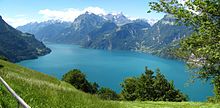
Lake Lucerne is singularly irregular and appears to lie in four different valleys, all related to the conformation of the adjoining mountains. The central portion of the lake lies in two parallel valleys whose direction is from west to east, the one lying north, the other south of the ridge of theBürgenstock.These are connected through a narrow strait, scarcely one kilometre wide, between the two rocky promontories called respectivelyUnter NasandOber Nas(Lower and Upper Nose). It is not unlikely that the southern of these two divisions of the lake—calledBuochser Bucht—formerly extended to the west over the isthmus whereon stands the town ofStans,thus forming an island of the Bürgenstock. The west end of the main branch of the lake, whence a comparatively shallow bay extends to the town of Lucerne, is intersected obliquely by a deep trench whose south-west end is occupied by the branch calledAlpnachersee,while the north-east branch forms the long arm ofKüssnacht,Küssnachtersee.These both lie in the direct line of a valley that stretches with scarcely a break in between theUri Alpsand theEmmental Alps.At the eastern end of the Gersauer Becken, where the containing walls of the lake-valley are directed from east to west, it is joined at an acute angle by the arm of Uri, or theUrnersee,lying in the northern prolongation of the deep cleft that gives a passage to theReuss,between theUri Alpsand theGlarus Alps.[4][unreliable source]

The Urnersee occupies the northernmost and deep portion of the great cleft of the Reuss Valley, which has cut through the Alpine ranges from theSt Gotthard Passto the neighbourhood ofSchwyz.From its eastern shore the mountains rise in almost bare walls of rock to a height of from 3,000 to 4,000 ft (910 to 1,220 m) above the water. The two highest summits are theFronalpstockand theRophaien(2078 m). Between them the steep glen or ravine of theRiemenstaldener Taldescends toSisikon,the only village withFlüelenright on the shore on that side of the Urnersee. On the opposite or western shore, the mountains attain still greater dimensions. TheNiederbauen Chulmis succeeded by theOberbauenstock,and farther south, above the ridge of the Scharti, appear the snowy peaks of theGitschenand theUri Rotstock(2,928 m). In the centre opens the Reuss Valley, backed by the rugged summits of theUrnerandGlarner Alps.[4]
The breadth of these various sections of the lake is very variable, but is usually between one and two miles (3 km). The lake's surface, whose mean height above the sea is 434 metres, is thelowest pointof the cantons of Uri, Obwalden and Nidwalden. Originally the lake was susceptible to variations in level and flooding along its shoreline. Between 1859 and 1860, the introduction of aneedle damin the Reuss in the city of Lucerne, just upstream from theSpreuerbrücke,allowed the lake level to be stabilised.[1]
The culminating point of the lake's drainage basin, as well as Central Switzerland, is theDammastockat 3,630 metres above sea level.[5]
Name[edit]
The name ofVierwaldstätterseeis first used in the 16th century. Before the 16th century, the entire lake was known asLuzerner See"Lake Lucerne", as remains the English (and partly Italian, asLago di Lucerna) usage.[1] The (three) "Waldstätte(n)"(lit.:" forested sites/settlements ", in English usually translated asforest cantons[6]) since the 14th century were the confederate allies ofUri,SchwyzandUnterwalden.The notion of "Four Waldstätten" (Vier Waldstätten), with the addition of thecanton of Lucerne,is first recorded in the 1450s, in an addition to the "Silver Book" ofEgloff Etterlinof Lucerne.
The nine different parts of the lake have individual designations:[1][7]
- Urnersee( "Lake of Uri" ): The first part of the lake, at the mouth of the Reuss betweenFlüelenandBrunnen.
- Gersauer Becken( "Basin of Gersau" ) next toGersaubelow theRigimassif is the deepest part of the lake.
- Buochser Bucht( "Bay of Buochs" ): The bay of Bouchs, where theEngelberger Aaenters the lake.
- Vitznauer Bucht( "Bay of Vitznau" ): The part between theBürgenstockand Rigi.
- Alpnachersee( "Lake of Alpnach" ): the almost separate, southern arm below the southern mountainside ofPilatusnearAlpnach.
- Stanser Trichter( "Funnel of Stans" ): The part north of the Pilatus, west of Bürgenstock, and in front ofHergiswilandStansstad.
- Küssnachtersee( "Lake of Küssnacht" ): The most northern arm, west of the Rigi withKüssnacht SZat its northern end.
- Chrütztrichter( "Cross Funnel" ): The meeting point ofStanser Trichter,Luzernersee,Küssnachtersee,andVitznauer Bucht.
- Luzernersee( "Lake of Lucerne" ): in German usage now limited to the bay at Lucerne as far as Meggenhorn, with its effluence of the Reuss.
Settlements[edit]
| Left shore[l 1] | Right shore |
|---|---|
|
|
| Luzern | |
[edit]


The lake is navigable, and has formed an important part of Switzerland's transport system for many centuries, and at least since the opening of the first track across theGotthard Passin 1230. This trade grew with the opening of a newmail coachroad across the pass in 1830. This road had its northern terminus atFlüelenat the extreme eastern end of the lake, and the lake provided the only practical onward link toLucerne,and hence the cities of northern Switzerland and beyond.[8][9]
Whilst the development of Switzerland's road and rail networks has relieved the lake of much of its through traffic, it continues to be used by a considerable number of vessels, both private and public. Much of this usage is tourist or leisure oriented, but the lake continues to provide practical public and cargo transport links between the smaller lakeside communities.
Passenger boats of theSchifffahrtsgesellschaft des Vierwaldstättersees(SGV) provide services on the lake, including many run by historicpaddle steamers.The SGV serves 32 places along the shore of the lake, with interchange to both main line and mountain railways at various points. Under separate management, theAutofähre Beckenried-Gersauprovides acar ferryservice betweenBeckenried,on the south bank of the lake, andGersauon the north.
Cargobarges,to a local design known asNauen,are still used on the lake. Some have been converted for use as party boats. Other barges are used by the gravel dredging industry that operates on the lake, using largedredgersto obtainsandandgravelfor use in theconstruction industry.[10][11]
Cultural references[edit]

Beethoven'sMoonlightSonataderives its name from an 1832 description of the first movement by poet and music criticLudwig Rellstab,who compared it to moonlight shining upon Lake Lucerne.
Gioacchino Rossiniuses this[clarification needed]in hisWilliam TellOvertureSection A: Sunrise over the Alps.
Rowing[edit]
Lake Lucerne has twice been used as a venue for theEuropean Rowing Championships:in1908and then in1926.[12][13]The nearbyRotseehas since 1933 been used for rowing regattas instead.
Tourism[edit]

On the way south, the English discovered the mountains of central Switzerland. Several spa and bathing resorts such as Weggis or Gersau were created. In 1871, the very first rack railway in Europe, the Vitznau-Rigi Railway, was opened. In 1889 the steepest cog railway in the world was built from Alpnachstad toMount Pilatus.Mark Twain described an ascent to the Rigi, which led to the blossoming of Swiss tourism in the United States in the 19th century. One of the largest steamship fleets in Europe operates with five steamships on Lake Lucerne.
In the area surrounding the lake and on terraces at medium height (for example Morschach and Seelisberg) there are numerous places for tourists. The Rigi, Pilatus, the Bürgenstock, theStanserhorn,the Buochserhorn, and the two legends, the Urirotstock and the Fronalpstock are attractive panoramic mountains near Lake Lucerne. Most of them can be reached by mountain railways, some of which have their valley station near boat stations on the lake.
There are numerous locations on the lake that are important in Swiss cultural and tourism history: Rütli, Tellsplatte, Tell Chapel, Carving Tower of Stansstad, Neu-Habsburg, Schillerstein, Treib, Astrid Chapel (Küssnacht) and Meggenhorn Castle.
Watersports[edit]
Different sports are possible in some separate areas due to the water and wind conditions. The lake is accessible from boat and yacht harbors, to lake resorts and pools (e.g. the Lido pool in Lucerne, built in 1929 by Arnold Berger). Therefore, the lake can be easily accessible from both shores. The See-Club Luzern was founded in 1881, which is now Switzerland's largest rowing club, as well as the Reuss Luzern rowing club (Ruderclub Reuss Luzern) in 1904. The Lucerne Yacht Club (Yachtclub Luzern) has existed since 1941 and has been running since 1966 a boathouse and buoy field on Churchill-Quai in Lucerne.
The Brunnen water sports club (Wassersportclub Brunnen), founded in 1958, held on Lake Lucerne in the first years of its existence international motorboat races and water ski championships. In 1965 the association chose a new name for the club: Lake Lucerne Water Sports Club (Wassersport-Club Vierwaldstättersee). The Central Switzerland Motorboat Club (Motorbootclub Zentralschweiz) was established in 1980 and the Hergiswil Water Sports Club (Wassersportclub Hergiswil) in 1986. SchweizMobil has created a canoe tour across Lake Lucerne between Brunnen and Gersau. Due to the wind in the Reuss Valley, the southern part of Lake Uri between the campground at Gruonbachstrand in Flüelen and Isleten is a center of windsurfing.
Diving[edit]
There are about ten places where you can dive without a boat in Lake Lucerne. The water is rather chilly all year round and therefore mostly very clear. In Lake Uri, at Sisikon, one can dive to a fragmented steep vertical wall, at the northern portal of the Schieferneggtunnel. The Lediwrack Bruno lies in front of Brunnen at a depth of 15 meters. Other well-known diving spots are in front of Vitznau, Weggis, Gersau and Hergiswil.
Notes and references[edit]
Notes[edit]
- ^The weir in Lucerne keeps the water level 2–3 m (6 ft 7 in – 9 ft 10 in) above the natural average, seeCanton of Lucerne, department of traffic and infrastructure (2008):Die Regulierung des Vierwaldstädtersees – Der Ausbau der Reusswehranlage in Luzern(PDF)Archived14 May 2014 at theWayback Machine
References[edit]
- ^abcdHans Stadler:VierwaldstätterseeinGerman,FrenchandItalianin the onlineHistorical Dictionary of Switzerland,27 February 2013.
- ^Archived atGhostarchiveand theWayback Machine:Switzerland - Lake Lucerne - Aerial Drone Video in 4K,retrieved10 May2021
- ^abDavis-Marks, Isis."3,000-Year-Old Submerged Settlement Discovered in Switzerland".Smithsonian Magazine.Retrieved7 May2021.
- ^abJohn Ball,The Alpine guide, Central Alps,p. 153, 1866, London
- ^1:25,000 topographic map(Map).Swisstopo.Retrieved27 July2014.
- ^for the translation "forest canton" see e.g. Encyclopedia Britannica, 7th ed., vol. 21 (1842),p. 44.
- ^"Vierwaldstättersee: Über sieben Becken..."(PDF).BeobachterNatur (in German). No. 8/2011. Zurich, Switzerland:Beobachter.7 October 2011.Retrieved7 October2016.
- ^"Paddle Steamboat Uri"(PDF).American Society of Mechanical Engineers.5 September 2008. Archived fromthe original(PDF)on 3 September 2014.Retrieved11 September2012.
- ^"Geschichte SGV"[SGV History] (in German). SGV.Retrieved12 September2012.
- ^"WABAG Kies AG"(in German). WABAG Kies AG.Retrieved10 September2012.
- ^"Arnold & Co. AG"(in German). Arnold & Co. AG.Retrieved11 September2012.
- ^"Event Information".International Rowing Federation.Retrieved30 June2018.
- ^"Event Information".International Rowing Federation.Retrieved30 June2018.
External links[edit]
- Waterlevels Lake LucerneatBrunnen
- Waterlevels Lake LucerneatLucerne
- Lake Lucerne Region
- Nidwalden Tourism
- Coolidge, William Augustus Brevoort(1911)..Encyclopædia Britannica.Vol. 17 (11th ed.). pp. 97–98.
- Lake Lucerne
- Lakes of Switzerland
- Lakes of the canton of Uri
- Lakes of the canton of Schwyz
- Lakes of Obwalden
- Lakes of Nidwalden
- Lakes of the canton of Lucerne
- Reuss basin
- Tourist attractions in the canton of Uri
- Tourist attractions in Nidwalden
- Nidwalden–Uri border
- Nidwalden–Obwalden border
- Lucerne–Nidwalden border
- Lucerne–Schwyz border
- Schwyz–Uri border
- Nidwalden–Schwyz border






